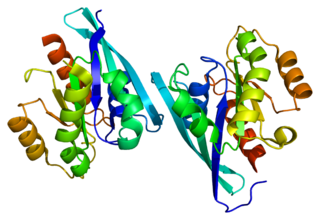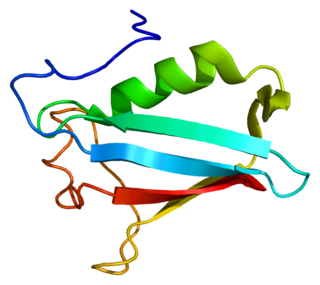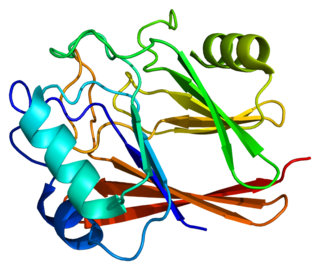Phosphatidylinositol 3,5-bisphosphate is one of the seven phosphoinositides found in eukaryotic cell membranes. In quiescent cells, the PtdIns(3,5)P2 levels, typically quantified by HPLC, are the lowest amongst the constitutively present phosphoinositides. They are approximately 3 to 5-fold lower as compared to PtdIns3P and PtdIns5P levels, and more than 100-fold lower than the abundant PtdIns4P and PtdIns(4,5)P2. PtdIns(3,5)P2 was first reported to occur in mouse fibroblasts and budding yeast S. cerevisiae in 1997. In S. cerevisiae PtdIns(3,5)P2 levels increase dramatically during hyperosmotic shock. The response to hyperosmotic challenge is not conserved in most tested mammalian cells except for differentiated 3T3L1 adipocytes.

Coatomer subunit beta is a protein that in humans is encoded by the COPB1 gene.

Mannose-6-phosphate receptor binding protein 1 (M6PRBP1) is a protein which in humans is encoded by the M6PRBP1 gene. Its gene product, as well as the gene itself, is commonly known as TIP47.

Alpha-centractin (yeast) or ARP1 is a protein that in humans is encoded by the ACTR1A gene.

Ras-related protein Rab-9A is a protein that in humans is encoded by the RAB9A gene.

PIKfyve, a FYVE finger-containing phosphoinositide kinase, is an enzyme that in humans is encoded by the PIKFYVE gene.

Ras-related protein Rab-1B is a protein that in humans is encoded by the RAB1B gene.

Golgin subfamily A member 3 is a protein that in humans is encoded by the GOLGA3 gene.

NSFL1 cofactor p47 is a protein that in humans is encoded by the NSFL1C gene.

Bicaudal D cargo adaptor 2 is a protein that in humans is encoded by the BICD2 gene.

VPS29 is a human gene coding for the vacuolar protein sorting protein Vps29, a component of the retromer complex.

Ras-related protein Rab-22A is a protein that in humans is encoded by the RAB22A gene.

Vesicle-associated membrane protein 4 is a protein that in humans is encoded by the VAMP4 gene.

Golgin subfamily A member 5 is a protein that in humans is encoded by the GOLGA5 gene.

ADP-ribosylation factor-related protein 1 is a protein that in humans is encoded by the ARFRP1 gene.

BET1 homolog is a protein that in humans is encoded by the BET1 gene.

Conserved oligomeric Golgi complex subunit 4 is a protein that in humans is encoded by the COG4 gene.

Transmembrane 9 superfamily member 2 is a protein that in humans is encoded by the TM9SF2 gene.

Vesicle transport through interaction with t-SNAREs homolog 1A is a protein that in humans is encoded by the VTI1A gene.

Protein VAC14 homolog, also known as ArPIKfyve, is a protein that in humans is encoded by the VAC14 gene.






















